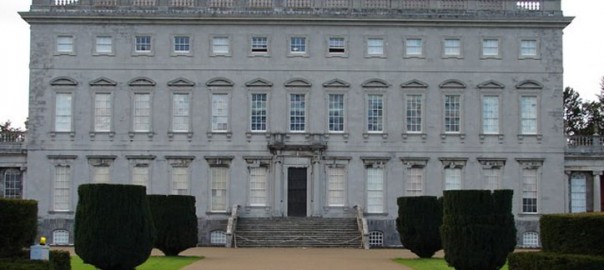Castletown House is Ireland’s largest and earliest Palladian style house. It was built between 1722 and 1729 for William Conolly, the Speaker of the Irish House of Commons. The facade was designed by the Italian architect, Alessandro Galilei; Irish architect Sir Edward Lovett Pearce added the wings.
Castletown was built with two wings – connected by Ionic colonnades – flanking the Renaissance-inspired central block of the house. The wings contained the kitchens on one side and the stables on the other. This “Palladian” style originated in Italy with the 16th century architect Andrea Palladio (1508-80), and came to prominence in England in the early eighteenth century.
The house remained in the hands of William Conolly’s descendants until 1965. Its future became uncertain but it was saved in 1967 when (along with 120 acres of the demesne lands) it was purchased by the Hon. Desmond Guinness, founder of the Irish Georgian Society. The house was opened to the public and restoration work began, funded by the Irish Georgian Society and private benefactors. In 1994 the house was transferred to State care and is now managed by the Office of Public Works.
Through restoration, conservation, acquisition of parkland and development of visitor facilities, one of the most important houses in Ireland (and one of significance in terms of European architectural heritage) is being preserved for future generations.
Castletown, in the words of Kevin B. Nowlan, former Professor of Modern History, is an Italian palace set on the banks of the River Liffey.
At the time it was built, contemporary commentators expected it to be no less than ‘the epitome of the Kingdom, and all the rarities she can afford’. It is indeed not only the greatest of Irish houses, but also home to a significant collection of paintings, furnishings and objects, many associated with the house since the eighteenth century. This is extraordinary, considering that most contents from the house were dispersed at various auctions, the largest one held at Castletown over three days in April 1966. It explains why Castletown was considered a leading conservation and restoration project after the Hon. Desmond Guinness bought it in 1967 and, with the help of the Irish Georgian Society, opened it to the public.
Desmond Guinness himself had been able to acquire a significant number of original contents – including important family portraits, statues, furniture and the set of three Murano glass chandeliers – from Lord Conolly-Carew before the auction, which he then returned to Castletown. Over the years, many benefactors generously gave or loaned other important items, contributing to the exquisite collection on display today. Their generosity and kindness is acknowledged in the house and is recorded in Castletown: Decorative Arts, the detailed catalogue of our collection published in 2011.
Most items in the collection today belong to the Castletown Foundation, which between 1979 and 1994 owned and managed Castletown. When the house passed into state ownership, the collection was given on long-term loan to the Office of Public Works (OPW). In the more than two decades since, the OPW has been working closely with the Castletown Foundation on the presentation of the house and, together, they have secured additional items for the collection, both through purchase and generous loans. For example, in 2014 OPW identified, purchased and repatriated a pair of fine French corner cabinets which had been commissioned by Lady Louisa Conolly. They are now back in the Red Drawing Room where they used to be.
Access to the house is only by guided tour. The tour covers all aspects of the history of Castletown House from 1722 right up to the present day. The diverse and fascinating Conolly family members who lived in the house are explained, and visitors get a chance to view the fine architecture, original furniture and vast collection of paintings within Castletown. The House is available for school tours and private groups throughout the year; advance booking is essential.
The Berkeley Costume and Toy Collection is a fine collection of 18th and 19th century costumes, toys and dolls. Countess Ann Griffin Bernstorff, the Irish artist and collector, assembled the collection as a private enthusiasm. Covering a period of some 80 years from 1740–1820, the exhibits range from rare and delicate artefacts to simple and robust playthings, and everyday garments of the past, many of which were once owned by Irish families. The costumes are on view during one’s tour of the house; unfortunately, the toys have been moved to the second floor, which is not open to the public.
You can have a look at the highlights of the Castletown collection here – https://castletown.ie/collection-highlights/
Opening Hours:
Castletown House is currently closed.
The Courtyard café is closed for the foreseeable future.
The opening hours of Castletown Estate have been reduced due to ongoing issues.
The current opening hours of the parklands are 08:30 to 5:30
Access times vary, check here for details.
Contact & Pricing:
castletown.ie
[email protected]
Tel: 01 6288252.
Celbridge, Co. Kildare
Adults €10; concessions. Free on the first Wednesday of every month.
